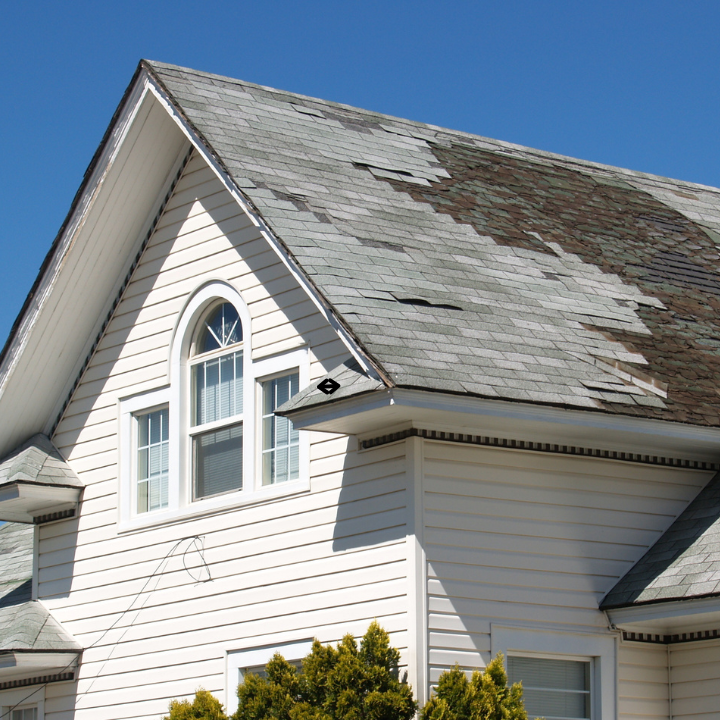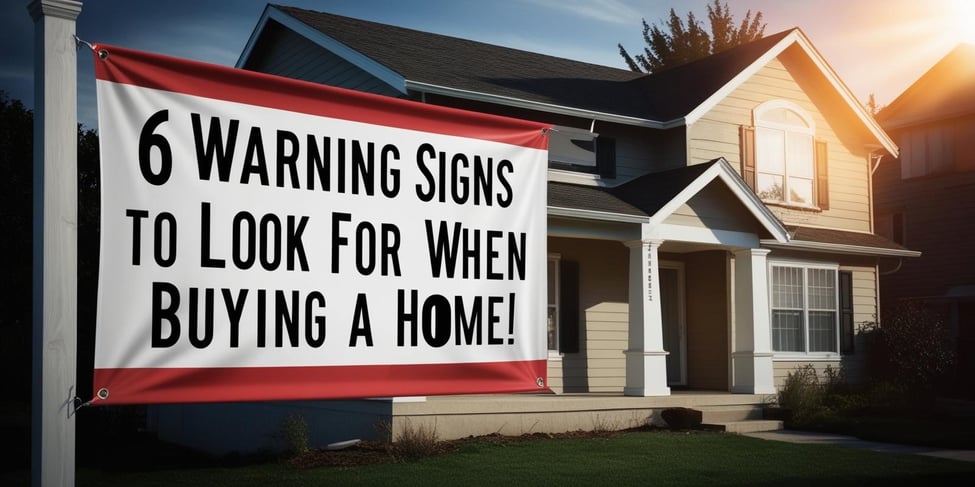🏡 6 Warning Signs to Look for When Buying a Home 🚩
Buying a home is a huge investment—one of the biggest decisions you’ll make in your lifetime. While it’s easy to fall in love with a property that has the perfect kitchen, a dreamy backyard, or an ideal location, you need to look beyond the surface to ensure you’re making a smart financial choice.
Many homes have hidden issues that aren’t obvious during a quick walkthrough. Some can be minor fixes, but others can lead to expensive repairs, safety hazards, or even major regret.
So, before you sign on the dotted line, here are six major warning signs 🚨 that could indicate trouble ahead!
1️⃣ Foundation Problems: Cracks, Slopes, and Uneven Floors
🔍 What to Look For:
• Large cracks in walls, floors, or ceilings
• Doors and windows that don’t close properly 🚪
• Uneven or sloping floors 📏
• Gaps between walls and ceilings
• Stair-step cracks on brick or concrete
💡 Why It’s a Problem:
A home’s foundation is its backbone. If the foundation is weak or damaged, the entire house is at risk. Foundation issues can cause walls to shift, floors to buckle, and doors/windows to misalign, creating ongoing structural problems.
Not all cracks mean disaster. Some hairline cracks occur naturally due to settling, but large or widening cracks (especially horizontal ones) could signal major foundation failure.
Worst-case scenario? Foundation repairs can cost anywhere from $5,000 to $50,000 or more, depending on severity.
🔧 What to Do:
1️⃣ Check all walls and floors carefully for cracks or uneven surfaces.
2️⃣ Use a marble test—place a marble on the floor and see if it rolls on its own (a sign of sloping floors).
3️⃣ If you see major cracks or shifts, hire a structural engineer 🏗️ to inspect the foundation.
🚨 Red flag: If the seller is avoiding direct answers about foundation issues or seems unwilling to negotiate repairs, walk away!
 2️⃣ Water Damage and Mold: A Silent Nightmare
2️⃣ Water Damage and Mold: A Silent Nightmare
💦 What to Look For:
• Stains on ceilings, walls, or floors (especially yellow or brown)
• Musty smell in the basement or bathrooms 🤢
• Peeling paint, warped floors, or swollen door frames
• Visible mold growth 🦠
• Water pooling around the foundation outside
💡 Why It’s a Problem:
Water damage is one of the most expensive and common issues in homes. If left untreated, it can cause:
✔️ Mold growth, which can lead to allergies and respiratory issues
✔️ Wood rot, weakening the home’s structure
✔️ Foundation damage, if water seeps into the base of the house
Even small leaks can lead to huge expenses. What may look like a minor water stain could be hiding major plumbing problems, roof leaks, or poor drainage issues.
🔧 What to Do:
1️⃣ Look under sinks, in basements, and around windows for any signs of water damage.
2️⃣ Sniff around! A musty smell can indicate hidden moisture problems.
3️⃣ Ask the seller if the home has ever had flooding issues—and verify with a home inspection!
🚨 Red flag: If mold is visible, the problem has likely been ignored for a long time. Mold remediation can cost anywhere from $500 to $6,000 or more, depending on severity.
3️⃣ Electrical Issues: Fire Hazards in Disguise
⚡ What to Look For:
• Flickering lights or frequent circuit breaker trips
• Outdated or faulty wiring (knob-and-tube or aluminum wiring)
• Burn marks or a burning smell near outlets 🔥
• Not enough electrical outlets (a sign of an outdated system)
• No GFCI outlets in kitchens and bathrooms (required for safety)
💡 Why It’s a Problem:
Faulty electrical systems aren’t just inconvenient—they’re dangerous! Electrical issues are one of the leading causes of house fires.
Older homes, especially those built before the 1970s, may have outdated wiring that isn’t up to modern safety standards. Some homes may also have DIY electrical work, which can be improperly installed and hazardous.
A full home rewire can cost $8,000 to $30,000, depending on the size of the home.
🔧 What to Do:
1️⃣ Test the lights, outlets, and breakers during your walkthrough.
2️⃣ Check for modern circuit breakers instead of old fuse boxes.
3️⃣ If the home is older than 40 years, hire an electrician to inspect the wiring before purchasing.
🚨 Red flag: If outlets spark, feel warm, or are discolored, the home may have an electrical overload issue—which is a serious fire hazard!
 4️⃣ Roofing Issues: A Costly Overlooked Expense
4️⃣ Roofing Issues: A Costly Overlooked Expense
🏚️ What to Look For:
• Missing, curling, or cracked shingles
• Water stains on ceilings (a sign of roof leaks)
• Sagging roof or visible damage from outside
• Signs of patchwork repairs
💡 Why It’s a Problem:
A bad roof can lead to water damage, insulation issues, and expensive repairs.
Most roofs last 20-30 years, depending on the material. If the roof is nearing the end of its lifespan, you could be looking at a replacement cost of $10,000 to $30,000.
🔧 What to Do:
1️⃣ Ask about the roof’s age and request maintenance records.
2️⃣ Check for missing shingles, sagging, or visible damage.
3️⃣ If unsure, get a roofing inspection before closing the deal!
🚨 Red flag: If the roof looks newly patched but only in certain areas, the seller may be covering up a bigger problem.
5️⃣ Poor Drainage and Grading: Future Flooding Risks
🚰 What to Look For:
• Water pooling around the foundation after rain
• Soggy or sloping yard towards the house
• Gutters clogged, broken, or missing
• Basement dampness or history of flooding
💡 Why It’s a Problem:
If water doesn’t drain away from the house, it can seep into the foundation, causing cracks, leaks, and structural damage.
Homes in flood-prone areas may also require expensive flood insurance, adding to your monthly costs.
🔧 What to Do:
1️⃣ Check the grading—the ground should slope away from the home, not toward it.
2️⃣ Inspect gutters and downspouts to ensure they properly direct water.
3️⃣ Ask about past basement flooding or water damage.
🚨 Red flag: If a home smells musty in the basement or has signs of prior flooding, walk away unless you’re willing to spend big on waterproofing!
6️⃣ Strange Odors and Hidden Pests: A Home’s Dirty Secrets
🐜 What to Look For:
• Strong musty smells (could indicate mold or mildew)
• Ammonia or urine-like smells (could mean pests or rodent infestations)
• Scratching sounds in walls or attic 🐀
• Tiny holes in wood (a sign of termites)
💡 Why It’s a Problem:
Pests like termites, rodents, and cockroaches can cause thousands of dollars in damage. Termites alone cause $5 billion in damage annually!
🔧 What to Do:
1️⃣ Look for droppings, dead bugs, or wood damage.
2️⃣ Check for small tunnels in walls or floors, which can indicate termite infestations.
3️⃣ If you suspect pests, hire a pest control professional before purchasing.
🚨 Red flag: If a home smells overwhelmingly like air fresheners, the seller may be trying to cover up a serious odor problem.
🏠 Final Thoughts: Trust Your Gut and Inspect Thoroughly!
A home may look perfect, but always dig deeper before buying. If you notice any red flags, use them as negotiation points or walk away if the risks are too high.
📌 Pro tip: Always get a professional home inspection—it could save you from a financial disaster! 💰
Have you ever encountered these warning signs when buying a home? Drop your experiences in the comments! ⬇️

